14 Oct
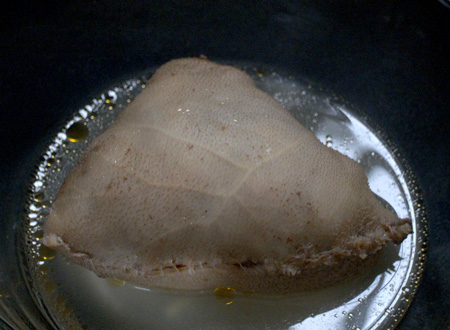
So, you saw what the tripe looked like when I got it back from the butchers. It wasn’t pretty and it smelled bad! As a result, it took forever to clean. I rinsed it in what seemed like a hundred changes of cold water and every time I changed the water, I had to hold my breath. As the dirty water poured into the sink, the smell became more intense. But the stink eventually subsided and the tripe started to whiten and look clean — I also stripped the strips of fat and muck off and scraped the dirty fuzz. And in a final push to get rid of the smell, I added a little Ecover dishwahsing soap to the water and washed the tripe as if it were a piece of cloth. The interesting thing was that one stomach cleaned really well while the other didn’t. It didn’t really matter. One was enough.
10 Oct
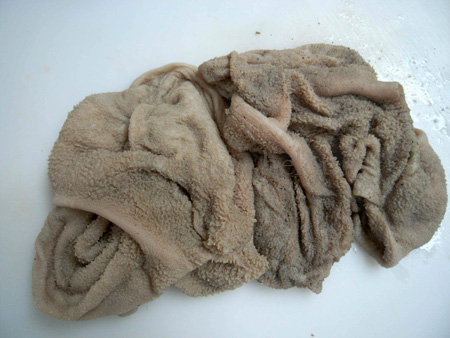
The last time I bought sheep’s tripe in London was fifteen years ago when I was testing recipes for The Fifth Quarter. It looked black and rather off-putting but I desperately needed some, so, I bought it. My mother, who was in London helping me, took one look at it and announced she couldn’t use it. It was just too dirty and would need too much scrubbing to clean up. So, we threw it away. And here I am today, giving tripe another try. I got the two stomachs in the picture from a wonderful Greek butcher up in Green Lanes. They are cleaner than those I bought so long ago but they are still pretty smelly and I have just spent half an hour cleaning them and stripping lining and fat off them — something we don’t need to do when we buy them from our butcher in Beirut. Tomorrow, I will finish cleaning them and will stuff them. I will post the recipe and pictures once I am done. So, stay tuned!
29 Apr
I have to say, I am very lucky. I have wonderful friends who I can stay with all over the world and just recently, I’ve been in Tehran, staying with my lovely friend, Nasrine Faghih. I didn’t expect Tehran to be an easy city but thanks to Nasrine and a charming young friend of hers, Ali who was my guide while I was there, I actually had a great time. Ali took me to lots of different places, including the big bazaar which I didn’t actually like much. It is nowhere near as magical as the souks of Aleppo and I much preferred Tajrish, the small bazaar near Nasrine’s home, which was way more exciting. Still the big bazaar was fun, and definitely worth visiting if only for people watching.
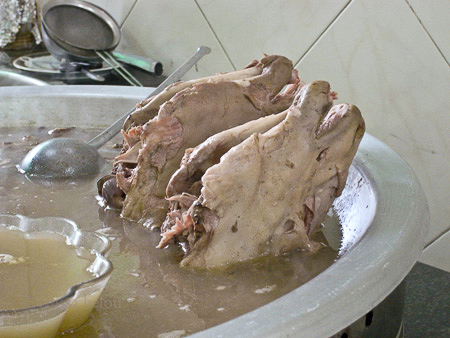
But what was far more interesting was the little cook-shop (called tabbakhi in Persian) just outside the main entrance to the bazaar, on the other side of the street, specializing in lamb’s heads and tripe. Some of you may know that I can’t resist offal ( I did after all write The Fifth Quarter) and as soon as I spotted the heads soaking in a large tub of broth, I dragged Ali inside.
18 Nov
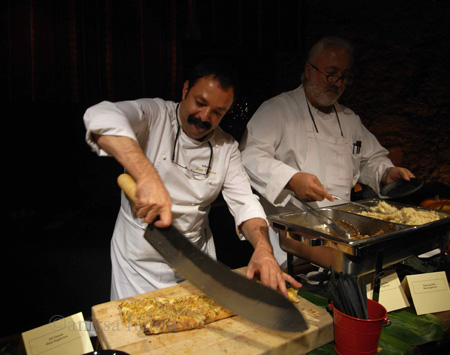
Well, I was going to post about chef Musa’s Adana kebab as a follow up to my previous post on street kebabs in Aleppo but then he brought out his special kebab knife, known as zirh in Turkish, which looks more like a sabre than a knife. It is used to chop meat for kebabs, or tripe for iskembe çorbasi (tripe soup) or the herbs and peppers that are mixed with the meat. Everyone in Turkey will tell you that there is no other way to chop these ingredients — the chopping has to be done by hand to get the right texture, and despite the zirh looking enormous and unwieldy, it is surprisingly easy to use, and as you can imagine, very efficient. So, I thought I’d post a few of the photos I had taken on various trips to Turkey showing the zirh in action .
Here is a black & white one of a tripe soup maker chopping an impressive amount of tripe.
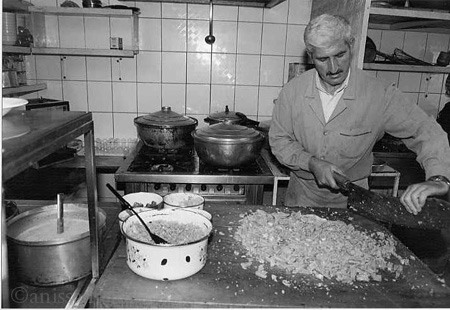
And here are a few which I shot in Gaziantep in the kitchens of Imam Cagdas, with each cook using his zirh to chop meat, herbs or peppers I think. Quite a sight.
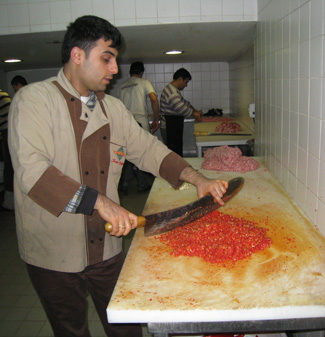
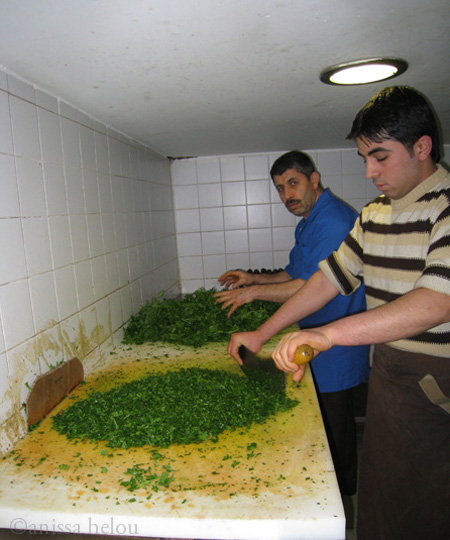
And here is a short, and I’m afraid not very good clip of all of the chefs at Imam Cagdas chopping away.
[vimeo]http://www.vimeo.com/7683754[/vimeo]
And finally, here is one of chef Musa, chef Burak and me in action at WOF which Zeynep, chef Musa’s wife snapped.

And here are two recipes, chef Musa’s Adana kebab and my tripe soup. As for my own zirh, I will post a picture of me using it in London. I can see it becoming an integral part of my demonstrations!
Chef Musa’s Adana Kebab
Yields 4
15 oz (450 g) lamb, shoulder and flank
1/3 oz (10 g) tail fat (from a male lamb)
1 red pepper, finely minced
1 shallot, finely minced
1 tbsp Maras chili pepper
- Using a knife or mezzaluna, mince the lamb and tail fat.
- Put the meat in a bowl. Add finely minced shallots.
- Discard the excess juice of minced red pepper and add in the bowl.
- Add Maras pepper. Mix all the ingredients well.
- Divide this mixture into 4 balls.
- Using wide metal skewers, put the meat onto skewers.
- Grill on oak charcoal.
- Serve on lavash bread.
©Musa Dagdiveren
Tripe Soup
Iskembe Çorbasi
Tripe, both sheep and ox, is a prized meat in most Mediterranean countries. In Italy, Spain and France, it is sold already cleaned and cooked. All you have left to do is dress it at home with your choice of sauce or garnish. However, in Middle Eastern countries, tripe is sold uncooked although, most of the time, already cleaned. You will still need to clean it further at home by washing it in several changes of soap and water. The following recipe comes from Turkey where there are many restaurants and cafés that specialize in tripe soup. A similar version of this soup is also popular in Greece (patsas) and, again, it is consumed early in the morning, after a night’s drinking. However, if you are horrified at the idea of eating offal or variety meats as it is known in the US, you can easily replace the tripe with lamb or chicken. Serves 6
10 ounce (300 g) piece of uncooked sheep’s tripe
sea salt
5 tablespoons (75 g) unsalted butter
1 1/2 tablespoons all-purpose flour
2 egg yolks
juice of half a lemon, or to taste
1 teaspoon Aleppo pepper
6 garlic cloves, crushed
1/2 cup white wine or champagne vinegar
1 – Wash the tripe in several changes of soap and water and rinse well. Put in a large saucepan and add 1 1/2 quarts (1 1/2 litres) water. Place over a medium-high heat, add salt to taste and bring to the boil. As the water comes to the boil, skim the surface clean then cover the pan, lower the heat and simmer for 1 1/2 hours or until tender.
2 – When the tripe is done, remove and slice into thin strips. Strain the stock and set aside.
3 – Melt 3 tablespoons butter in a clean saucepan and stir in the flour. Slowly add the strained tripe stock while continuing to stir. Add the tripe and simmer for another 5 minutes.
4 – Beat the eggs with the lemon juice.
5 – Melt the rest of the butter in a frying pan. Stir in the Aleppo pepper. Add a little of the hot soup liquid to the egg mixture then pour the egg mixture into the soup stirring all the time. Remove from the heat and stir in the garlic and vinegar. Usually the garlic-vinegar mixture is served on the side for people to help themselves but I prefer to mix it all in.
6 – Taste and adjust the seasoning of the soup then pour into a pre-heated tureen and drizzle the flavored butter all over. Serve very hot with good bread.
©anissa helou, from Mediterranean Street Food
